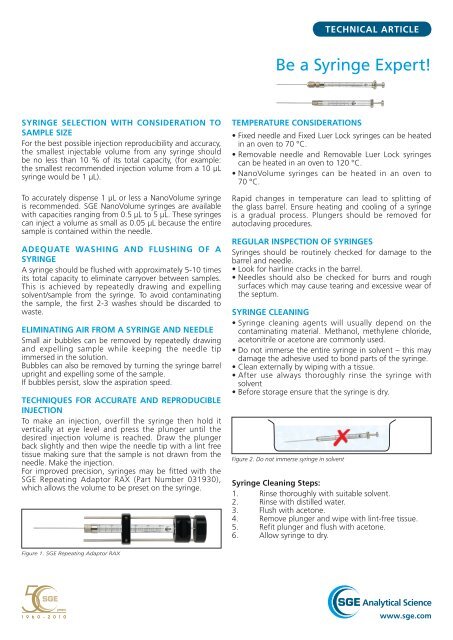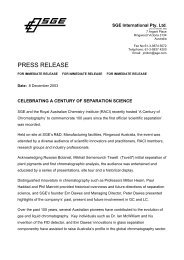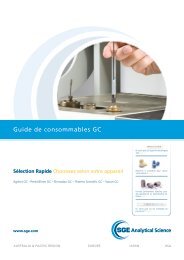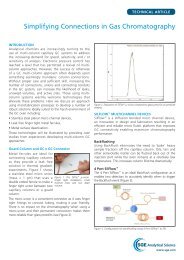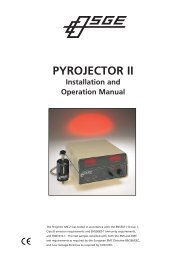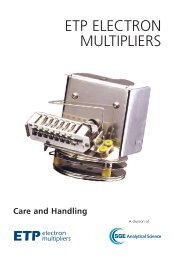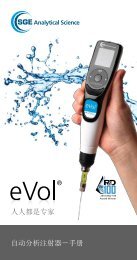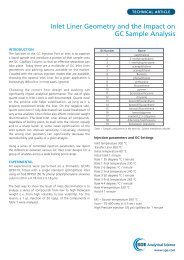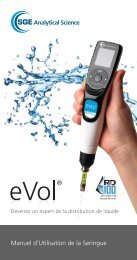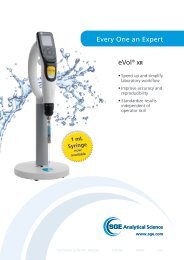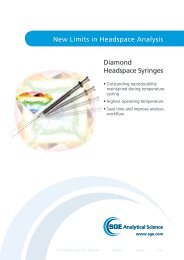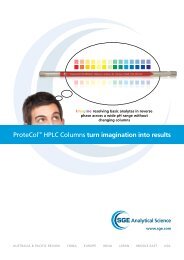Be a Syringe Expert! - SGE Analytical Science
Be a Syringe Expert! - SGE Analytical Science
Be a Syringe Expert! - SGE Analytical Science
Create successful ePaper yourself
Turn your PDF publications into a flip-book with our unique Google optimized e-Paper software.
SyRINgE SELECTIoN wITH CoNSIdERATIoN To<br />
SAmpLE SIzE<br />
For the best possible injection reproducibility and accuracy,<br />
the smallest injectable volume from any syringe should<br />
be no less than 10 % of its total capacity, (for example:<br />
the smallest recommended injection volume from a 10 μL<br />
syringe would be 1 μL).<br />
To accurately dispense 1 μL or less a NanoVolume syringe<br />
is recommended. <strong>SGE</strong> NanoVolume syringes are available<br />
with capacities ranging from 0.5 μL to 5 μL. These syringes<br />
can inject a volume as small as 0.05 μL because the entire<br />
sample is contained within the needle.<br />
AdEquATE wASHINg ANd fLuSHINg of A<br />
SyRINgE<br />
A syringe should be flushed with approximately 5-10 times<br />
its total capacity to eliminate carryover between samples.<br />
This is achieved by repeatedly drawing and expelling<br />
solvent/sample from the syringe. To avoid contaminating<br />
the sample, the first 2-3 washes should be discarded to<br />
waste.<br />
ELImINATINg AIR fRom A SyRINgE ANd NEEdLE<br />
Small air bubbles can be removed by repeatedly drawing<br />
and expelling sample while keeping the needle tip<br />
immersed in the solution.<br />
Bubbles can also be removed by turning the syringe barrel<br />
upright and expelling some of the sample.<br />
If bubbles persist, slow the aspiration speed.<br />
TECHNIquES foR ACCuRATE ANd REpRoduCIbLE<br />
INjECTIoN<br />
To make an injection, overfill the syringe then hold it<br />
vertically at eye level and press the plunger until the<br />
desired injection volume is reached. Draw the plunger<br />
back slightly and then wipe the needle tip with a lint free<br />
tissue making sure that the sample is not drawn from the<br />
needle. Make the injection.<br />
For improved precision, syringes may be fitted with the<br />
<strong>SGE</strong> Repeating Adaptor RAX (Part Number 031930),<br />
which allows the volume to be preset on the syringe.<br />
Figure 1. <strong>SGE</strong> Repeating Adaptor RAX<br />
TECHNICAL ARTICLE<br />
<strong>Be</strong> a <strong>Syringe</strong> <strong>Expert</strong>!<br />
TEmpERATuRE CoNSIdERATIoNS<br />
• Fixed needle and Fixed Luer Lock syringes can be heated<br />
in an oven to 70 °C.<br />
• Removable needle and Removable Luer Lock syringes<br />
can be heated in an oven to 120 °C.<br />
• NanoVolume syringes can be heated in an oven to<br />
70 °C.<br />
Rapid changes in temperature can lead to splitting of<br />
the glass barrel. Ensure heating and cooling of a syringe<br />
is a gradual process. Plungers should be removed for<br />
autoclaving procedures.<br />
REguLAR INSpECTIoN of SyRINgES<br />
<strong>Syringe</strong>s should be routinely checked for damage to the<br />
barrel and needle.<br />
• Look for hairline cracks in the barrel.<br />
• Needles should also be checked for burrs and rough<br />
surfaces which may cause tearing and excessive wear of<br />
the septum.<br />
SyRINgE CLEANINg<br />
• <strong>Syringe</strong> cleaning agents will usually depend on the<br />
contaminating material. Methanol, methylene chloride,<br />
acetonitrile or acetone are commonly used.<br />
• Do not immerse the entire syringe in solvent – this may<br />
damage the adhesive used to bond parts of the syringe.<br />
• Clean externally by wiping with a tissue.<br />
• After use always thoroughly rinse the syringe with<br />
solvent<br />
• <strong>Be</strong>fore storage ensure that the syringe is dry.<br />
Figure 2. Do not immerse syringe in solvent<br />
<strong>Syringe</strong> Cleaning Steps:<br />
1. Rinse thoroughly with suitable solvent.<br />
2. Rinse with distilled water.<br />
3. Flush with acetone.<br />
4. Remove plunger and wipe with lint-free tissue.<br />
5. Refit plunger and flush with acetone.<br />
6. Allow syringe to dry.
TA-0003-S_RevB © <strong>SGE</strong> <strong>Analytical</strong> <strong>Science</strong> Pty Ltd 02/2011<br />
TECHNICAL ARTICLE<br />
pLuNgER CARE<br />
metal plungers for Standard <strong>Syringe</strong>s<br />
• Never force the plunger.<br />
• Replacement plungers for standard syringes are not<br />
available. Plungers are individually fitted to the barrels to<br />
achieve a perfect seal, therefore these plungers are not<br />
interchangeable.<br />
• A perfectly sealing plunger may appear to be loose in<br />
the barrel.<br />
• If the plunger action in the barrel starts to bind, follow<br />
the cleaning procedure outlined under “<strong>Syringe</strong><br />
Cleaning”.<br />
• Avoid unnecessary movement of the plunger when the<br />
syringe is dry. Dry pumping of the plunger may cause<br />
damage or seizing to occur.<br />
metal plungers for NanoVolume <strong>Syringe</strong>s<br />
• Always loosen needle cover nut before removing or<br />
inserting NanoVolume syringe plunger.<br />
• Care should be taken if the plunger is removed from the<br />
syringe.<br />
• Wipe plunger with a lint-free tissue before replacing into<br />
the syringe.<br />
• A heated syringe cleaner is recommended for cleaning<br />
needles and plungers of NanoVolume syringes.<br />
pTfE Tipped plungers<br />
• Avoid unnecessary movement of plungers when the<br />
syringe is dry.<br />
• Replacement PTFE tipped plungers are available.<br />
NEEdLE CARE<br />
Needle Selection<br />
The inside diameter of <strong>SGE</strong> syringe needles have been<br />
selected to ensure minimal dead volume without<br />
compromising the ability of the syringe to draw samples of<br />
normal viscosity. Medium to high viscosity samples should<br />
be diluted or a larger ID needle may be required.<br />
To reduce the possibility of bending, choose the widest<br />
available needle outside diameter suitable for the<br />
application. Autosampler syringes with 0.63mm OD needles<br />
should be selected for all applications except on-column<br />
injection.<br />
<strong>SGE</strong> makes various needle tip styles to suit a range of<br />
applications and uses. The two most common tip styles are:<br />
• Cone - frequently used on autosampler syringes<br />
• <strong>Be</strong>vel - popular for manual injection.<br />
Needle blockages<br />
If a needle blockage occurs, remove the plunger and fill the<br />
syringe with solvent using another syringe. Insert the plunger<br />
and gently push solvent through the needle.<br />
Never force the plunger as too much pressure may crack the<br />
syringe barrel.<br />
Needle Cleaning<br />
• The <strong>SGE</strong> Needle Cleaning Kit (Part Number 031782)<br />
contains a range of stylet wires for needle cleaning,<br />
tweezers and a surfactant material for barrel cleaning.<br />
• The <strong>SGE</strong> Heated <strong>Syringe</strong> Cleaner (Part Number 031780<br />
- 110/120 volts or Part Number 031781 - 220/240 volts)<br />
removes organic residues from needle and is particularly<br />
useful for syringe cleaning when performing trace analysis.<br />
External Needle Surfaces<br />
Burrs and surface roughness on needles can be cleaned by<br />
using fine emery cloth or carborundum paper. Ensure that<br />
the needle is washed thoroughly after deburring.<br />
SyRINgE VALIdATIoN<br />
Every <strong>SGE</strong> syringe is supplied with a “Conformance<br />
Certificate” which guarantees it conforms to quality and<br />
volume specifications. It also provides volume traceability<br />
back to International Standards.<br />
Factory calibrated syringes are available upon request.<br />
For more information contact contact our technical our technical customer customer support team support on: techsupport@sge.com<br />
team on: techsupport@sge.com<br />
AuSTRALIA & pACIfIC REgIoN<br />
<strong>SGE</strong> <strong>Analytical</strong> <strong>Science</strong> Pty Ltd<br />
Toll Free: 1800 800 167<br />
Tel: +61 (0) 3 9837 4200<br />
Fax: +61 (0) 3 9874 5672<br />
Email: support@sge.com<br />
EuRopE<br />
<strong>SGE</strong> Europe Ltd<br />
European Head Office<br />
Toll Free: 00800 2790 8999<br />
Toll Free Fax: 00800 2626 2609<br />
Tel: +44 1908 568 844<br />
Fax: +44 1908 566 790<br />
Tel France: +33 1 69 29 80 90<br />
Fax France: +33 1 69 29 09 25<br />
Tel Germany: +49 (0) 6155 / 60746 0<br />
Fax Germany: +49 (0) 6155 / 60746 50<br />
Email: europe@sge.com<br />
CHINA<br />
<strong>SGE</strong> Shanghai Representative Office<br />
Tel: +86 21 6407 9382<br />
Fax: +86 21 6407 9386<br />
Email: china@sge.com<br />
INdIA<br />
<strong>SGE</strong> Laboratory Accessories Pvt Ltd<br />
Tel: +91 22 24715896<br />
Fax: +91 22 24716592<br />
Email: sgeindia@vsnl.com<br />
jApAN<br />
<strong>SGE</strong> Japan Inc<br />
Tel: +81 45 222 2885<br />
Fax: +81 45 222 2887<br />
Email: japan@sge.com<br />
Figure 3. Needle Cleaning Kit<br />
mIddLE EAST<br />
<strong>SGE</strong> Gulf<br />
Tel: +971 6 557 3341<br />
Fax: +971 6 557 3541<br />
Email: gulfsupport@sge.com<br />
uNITEd STATES of AmERICA<br />
<strong>SGE</strong> Incorporated<br />
Toll Free: (800) 945 6154<br />
Tel: +1 512 837 7190<br />
Fax: +1 512 836 9159<br />
Email: usa@sge.com<br />
Figure 4. Heated <strong>Syringe</strong> Cleaner


